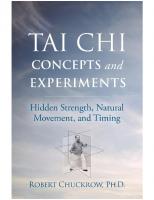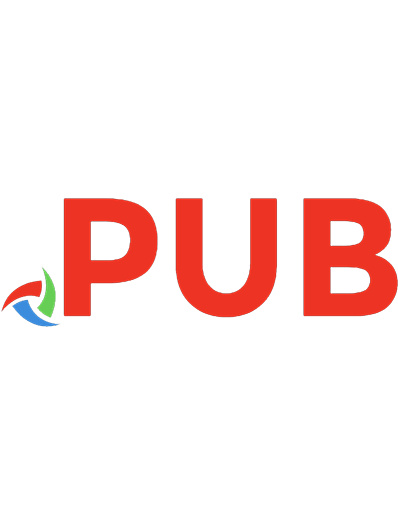Tai Chi Concepts and Experiments: Hidden Strength, Natural Movement, and Timing 9781594397424, 2021930021, 1594397414
The Tai Chi Concepts and Experiments book clarifies and makes accessible critical aspects of the art that are currently
407 108 14MB
English Pages 240 Year 2021
Table of contents :
Author’s Note
Introduction
Chapter 1: “Relax”
Cheng Man-ch’ing
Yang Cheng-fu
The Meaning of Relax
Attaining Song
The Importance of Releasing Tension in Doing Taiji Movement Stability (Root)
Push-Hands
A Seeming Contradiction
Shedding Some Light on the No-Strength Paradox
Chapter 2: Expansive Strength
Background
The Current View of Muscular Action
Differences between Contractive and Expansive Strength
Some Experiential Evidence for Expansive Strength (Experiments You Can Do)
A Promising Mechanism for Expansive Strength
Chapter 3: “Swimming on Land”
Professor Cheng’s Advice
My Initial Skepticism
My Eventual Realization
The Mental Aspect
“Zombie-Style Taiji”
Swimming on Land Is Only a Tool for Recognizing Nei Jin
Chapter 4: Elucidation of Famous Masters’ Sayings on Mind, Qi, and Strength
Li, Jin, and Nei Jin
Qi, Breath, and Internal and External Strength
An Analysis of Cheng Man-ch’ing’s Distinction between Two Different Types of Strength
An Attempt to Further Elucidate What Professor Cheng Wrote
An Analysis of Yang Cheng-fu’s Commentary on Strength
Breath and the Dan Tian
Health Aspects
Martial Aspects
Mind, Breath, Qi, and Strength
Summary
Chapter 5: Advantages of Expansion over Contraction in Taiji
Briskness of Regulation of Strength Compared for Both Types of Strength
Stability
Neutralization
Alertness
Endurance and Health Benefits
Leverage and Fine-Motor Control
Developing Bodily Unification
Educating Bioelectrical Pathways
Deception in Self-Defense
Chapter 6: Health Protocols Using Expansion
Expansion for Reeducating Upper-Back Alignment
Expansion for Reeducating the Lower Back
Improving the Cervical Spine Using Slow, Relaxed Movement
Expansion for Relieving Plantar Fasciitis
Chapter 7: Balance
Gravity
Leg Strength and Mobility
Finding the Centers of the Feet
Knee, Ankle, Arch Alignment
Center of Mass
Balance Experiments
Vision
Other Factors
Chapter 8: An Analysis of “Rooting and Redirecting”
Conditions for Optimal Stability
Internal Aspects
Chapter 9: Natural Movement
Understanding Natural Movement
Elements of Natural Movement
Independence of Movement
Reasons for Studying Natural Movement
Attaining Natural Movement
Tools for Studying Natural Movement
Some Basic Physics Concepts
Animate and Inanimate Natural Movement
Chapter 10: Stepping Like a Cat
Taiji Stepping
Yin and Yang
Weight Transfer
Difficulties in Stepping Like a Cat
Order of Stepping: Heel First, Toe First, or Whole Foot?
Practicing Stepping to the Side Using a Movement from the Taiji Form
Stepping Naturally
The Swing of the Rear Leg During Stepping Forward
The Swing of the Forward Leg During Stepping Forward
Stepping at the Right Moment
Experiments for Attaining Proper Stepping
Swing of the Arms During Walking
Chapter 11: Periodic Movement and Its Timing
Periodic Motion
Periodic Motion Terms
Driven Periodic Motion
Linear, Driven, Horizontal Periodic Motion (“Withdraw and Push”)
Analysis of the Motion in “Withdraw and Push”
Importance of Timing of “Withdraw and Push”
Circular Motion of Right Arm in “Single Whip”
Centrifugal Effect
Centrifugal Effect with Gravity
Conical Pendulum
“Swinging”—Turning the Body about a Vertical Axis, Arms Swinging Side to Side
Benefits of Swinging
Ti Fang
Chapter 12: Additional Physical Concepts
Constraints
Rolling Without Slipping
Chapter 13: A Clarification of “Secret” Teachings Revealed by Cheng Man-ch’ing
Basic Concepts
Neutralizing
Attacking
Yearning K. Chen’s Alternative Way of Deflecting an Attack
In Conclusion
Chapter 14: Non-Intention, Intention, and “a Hand Is Not a Hand”
Non-Intention
The Mental Transmission of Intention
“A Hand Is Not a Hand”
The Transmission of Intention Over a Distance
Chapter 15: Maximizing Your Progress in Taiji
Studying Taiji
Obstacles to Learning Taiji
Dealing with Obstacles
Dangers of Overusing Images in Movement Arts
Validating Your Progress
Chapter 16: Perspectives on Taiji
Internal Versus External Martial Arts
Lifting Versus Lowering
Empty/Full, Yin/Yang Paradox
Some Variations of the Taiji Symbol
Taiji “Weapons”
Misinterpretations
The Yang Long Form and Professor Cheng’s Short Form
The Popularization of Taiji
Afterword
Acknowledgments
Appendix 1: Supplement to Chapters 8 and 9
Basics of Vector Addition
Vectors
Appendix 2: Supplement to Chapter 8
Analysis of Forces in Rooting
Appendix 3: Supplement to Chapter 9
Analysis of Swing of Hanging Rods
Bibliography
Internet References
Index
About the Author






![Tai Chi Qigong The Internal Foundation of Tai Chi Chuan [Revised Edition]
9781594392689, 9781594392702, 9781594392801, 1594392684](https://dokumen.pub/img/200x200/tai-chi-qigong-the-internal-foundation-of-tai-chi-chuan-revised-edition-9781594392689-9781594392702-9781594392801-1594392684.jpg)



